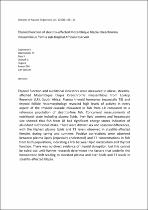 ResearchSpace
ResearchSpace
Thyroid function of steatitis-affected Mozambique tilapia Oreochromis mossambicus from a sub-tropical African reservoir
JavaScript is disabled for your browser. Some features of this site may not work without it.
- ResearchSpace
- →
- Research Publications/Outputs
- →
- Journal Articles
- →
- View Item
| dc.contributor.author |
Dabrowski, J

|
|
| dc.contributor.author |
Oberholster, Paul J

|
|
| dc.contributor.author |
Steyl, J

|
|
| dc.contributor.author |
Osthoff, G

|
|
| dc.contributor.author |
Hugo, A

|
|
| dc.contributor.author |
Power, DM

|
|
| dc.contributor.author |
Van Wyk, JH

|
|
| dc.date.accessioned | 2017-11-10T10:00:35Z | |
| dc.date.available | 2017-11-10T10:00:35Z | |
| dc.date.issued | 2017-07 | |
| dc.identifier.citation | Dabrowski, J. et al. 2017. Thyroid function of steatitis-affected Mozambique tilapia Oreochromis mossambicus from a sub-tropical African reservoir. Diseases of Aquatic Organisms, vol. 125(2): 101-113 | en_US |
| dc.identifier.issn | 0177-5103 | |
| dc.identifier.uri | doi: 10.3354/dao03138 | |
| dc.identifier.uri | https://www.ncbi.nlm.nih.gov/pubmed/28737156 | |
| dc.identifier.uri | http://www.int-res.com/articles/dao2017/125/d125p101.pdf | |
| dc.identifier.uri | http://hdl.handle.net/10204/9763 | |
| dc.description | Copyright: 2017 Inter-Research. Due to copyright restrictions, the attached PDF file only contains the abstract of the full text item. For access to the full text item, kindly consult the publisher's website. | en_US |
| dc.description.abstract | Thyroid function and nutritional indicators were measured in obese, steatitis-affected Mozambique tilapia Oreochromis mossambicus from Loskop Reservoir (LR), South Africa. Plasma thyroid hormones (especially T3) and thyroid follicle histomorphology revealed high levels of activity in every aspect of the thyroid cascade measured in fish from LR compared to a reference population of steatitis-free fish. Concurrent measurements of nutritional state including plasma lipids, liver lipid content and hepatocyte size showed that fish from LR had significant energy stores indicative of abundant nutritional intake. There were distinct sex and seasonal differences, with the highest plasma lipids and T3 levels observed in steatitis-affected females during spring and summer. Positive correlations were observed between plasma lipids (especially cholesterol) and T3 concentrations in fish from both populations, indicating a link between lipid metabolism and thyroid function. There was no direct evidence of thyroid disruption, but this cannot be ruled out until further research determines the factors that underlie the homeostatic shift leading to elevated plasma and liver lipids and T3 levels in steatitis-affected tilapia. | en_US |
| dc.language.iso | en | en_US |
| dc.publisher | Inter-Research, Germany | en_US |
| dc.relation.ispartofseries | Worklist;19753 | |
| dc.subject | Thyroid follicle | en_US |
| dc.subject | Pansteatitis | en_US |
| dc.subject | Obesity | en_US |
| dc.subject | Yellow fat disease | en_US |
| dc.subject | Olifants River | en_US |
| dc.subject | Loskop reservoir | en_US |
| dc.title | Thyroid function of steatitis-affected Mozambique tilapia Oreochromis mossambicus from a sub-tropical African reservoir | en_US |
| dc.type | Article | en_US |
| dc.identifier.apacitation | Dabrowski, J., Oberholster, P. J., Steyl, J., Osthoff, G., Hugo, A., Power, D., & Van Wyk, J. (2017). Thyroid function of steatitis-affected Mozambique tilapia Oreochromis mossambicus from a sub-tropical African reservoir. http://hdl.handle.net/10204/9763 | en_ZA |
| dc.identifier.chicagocitation | Dabrowski, J, Paul J Oberholster, J Steyl, G Osthoff, A Hugo, DM Power, and JH Van Wyk "Thyroid function of steatitis-affected Mozambique tilapia Oreochromis mossambicus from a sub-tropical African reservoir." (2017) http://hdl.handle.net/10204/9763 | en_ZA |
| dc.identifier.vancouvercitation | Dabrowski J, Oberholster PJ, Steyl J, Osthoff G, Hugo A, Power D, et al. Thyroid function of steatitis-affected Mozambique tilapia Oreochromis mossambicus from a sub-tropical African reservoir. 2017; http://hdl.handle.net/10204/9763. | en_ZA |
| dc.identifier.ris | TY - Article AU - Dabrowski, J AU - Oberholster, Paul J AU - Steyl, J AU - Osthoff, G AU - Hugo, A AU - Power, DM AU - Van Wyk, JH AB - Thyroid function and nutritional indicators were measured in obese, steatitis-affected Mozambique tilapia Oreochromis mossambicus from Loskop Reservoir (LR), South Africa. Plasma thyroid hormones (especially T3) and thyroid follicle histomorphology revealed high levels of activity in every aspect of the thyroid cascade measured in fish from LR compared to a reference population of steatitis-free fish. Concurrent measurements of nutritional state including plasma lipids, liver lipid content and hepatocyte size showed that fish from LR had significant energy stores indicative of abundant nutritional intake. There were distinct sex and seasonal differences, with the highest plasma lipids and T3 levels observed in steatitis-affected females during spring and summer. Positive correlations were observed between plasma lipids (especially cholesterol) and T3 concentrations in fish from both populations, indicating a link between lipid metabolism and thyroid function. There was no direct evidence of thyroid disruption, but this cannot be ruled out until further research determines the factors that underlie the homeostatic shift leading to elevated plasma and liver lipids and T3 levels in steatitis-affected tilapia. DA - 2017-07 DB - ResearchSpace DP - CSIR KW - Thyroid follicle KW - Pansteatitis KW - Obesity KW - Yellow fat disease KW - Olifants River KW - Loskop reservoir LK - https://researchspace.csir.co.za PY - 2017 SM - 0177-5103 T1 - Thyroid function of steatitis-affected Mozambique tilapia Oreochromis mossambicus from a sub-tropical African reservoir TI - Thyroid function of steatitis-affected Mozambique tilapia Oreochromis mossambicus from a sub-tropical African reservoir UR - http://hdl.handle.net/10204/9763 ER - | en_ZA |





